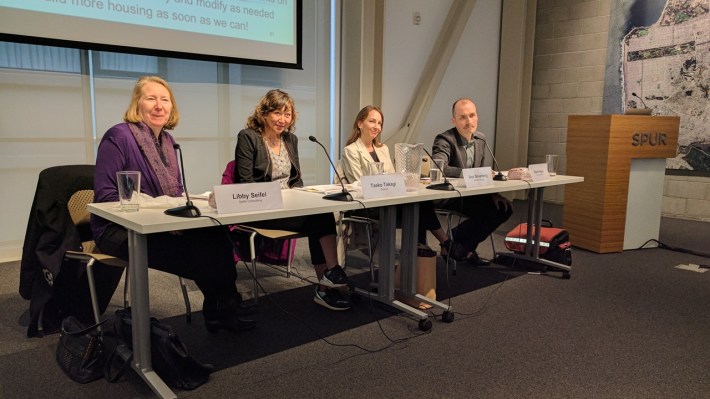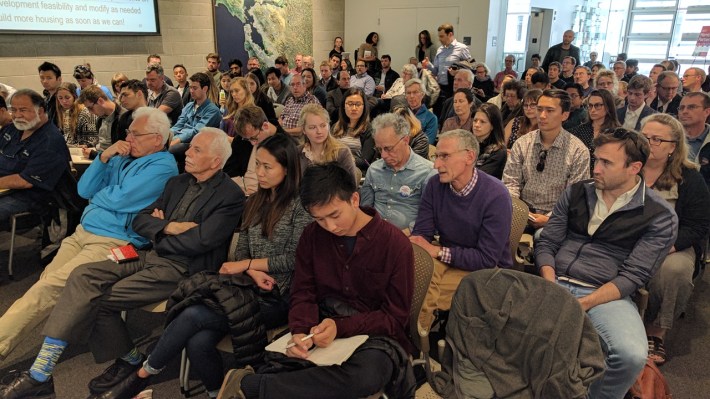SPUR Talk: Why is Housing so Expensive?
4:25 PM PDT on May 31, 2017

Image: Pixabay.
The San Francisco Bay Area Planning and Urban Research Association (SPUR), during a lunchtime presentation yesterday, developed a blueprint to bring down Bay Area housing prices in five years, so that everyone who wants to live in the city can afford a home.
Actually, they didn't do that. But it would have been nice.
Instead, they listed all the reasons housing prices are so high and offered some suggestions for how advocates can help supply get more in line with demand. "Sales prices have continued to rise--most new condos are in the $1,200 to $1,400 per square foot range," said Mark Hogan of OpenScope Studio, which designs in-fill housing projects.
What's driving that cost--or, more importantly, what could help remove the upward thrust? Hogan, using a small, 640 square foot condo as an example, said one of the most straight forward things would be to remove parking requirements. While explaining that land costs vary widely, roughly speaking each parking spot adds "$35,000 per space which assumes mechanical parking stackers inside a building."
And even if the parking is built without expanding the footprint of the project, it still jacks up costs. Buildings get higher which, sometimes, even changes the construction type to bear the extra mass. Or builders have to dig underground parking, which, again, makes building more complicated and expensive.
He added up other costs which quickly propel new construction into the stratosphere, with financing costs, labor, and permits. And then, while progressives generally support it, Below Market Rate (BMR) requirements don't just provide cheaper units out of thin air. "In order to provide 18 percent of the units as BMR, $87,805 in gap funding is added to the cost of producing each market rate unit."
He explained that construction/labor costs aren't even that big a factor, when weighed against all others, dispelling the idea that there are simple ways to bring down prices. "When we hear shipping containers will solve the housing crisis, that doesn’t even cut one-third of the costs of bringing a unit to market."
That isn't to say labor is not a big issue--at least finding enough of it. Ann Silverberg of BRIDGE Housing, which develops affordable housing for workers and seniors, said the recession is still having a residual effect on construction.
"The recession was shorter than people expected; we have not been able to get enough workers back," Silverberg said.
She explained that construction workers moved away from California or left the industry entirely, so now there's huge demand for workers--who also can't afford to live near Bay Area job sites, explained Taeko Takagi of Pankow, a construction company.
"Over 50 percent of our laborers come from 50 miles outside of the job site. That’s not productive," Takagi said.
Sometimes contractors have to put up work crews in hotels during the week. It's also nearly impossible to find subcontractors in the area, such as electricians and plumbers, who are always in demand, they said. That also jacks up prices.
In addition, because of the cyclical nature of building, it's really hard to steadily train new workers, since they end up leaving the industry, as they did in the great recession.
"We’ve grown about one percent per year," said Takagi. "While the world economy moves at around 2.8 percent and tech grows at 3-to-4 percent per year...we have to squish that gap."
Silverberg and Takagi also blamed heavy regulation for making building--and growth in the construction trades--so slow. "We have to streamline the permitting process. Identify issues often and early," said Takagi. "I’m not against regulations...we have healthier, safer buildings because of regulations, but they do add time and costs."

The key, said the panelists, is making sure the regulations are consistent and don't jam up the timeline of a project because of changes and unpredictable interpretations.
"San Francisco is really difficult--you might have some community opposition to affordable or community housing, meaning entitlements are never certain, they take a long time, they cost a lot of money," said Silverberg. "We had a project we had to walk away from when it became irresponsible to keep pursuing the entitlement."
So if regulations, labor and land costs aren't enough of a burden, don't forget financing.
"Equity is the most expensive source of capital and equity is needed [to start any housing project] because lenders are only willing to lend 65 to 75 percent," said Libby Seifel, a development consultant. "So equity is more expensive the longer you carry it."
What that means is every time the community objects to something about a development, the timeline gets stretched, and costs go up because of the delays--investors expect a greater return the longer it takes, driving up the capital costs.
The panelists called on SPUR members to lobby lawmakers to streamline permitting requirements. They praised Home-SF, for example, which gives an opportunity to lift density requirements, which can make housing cheaper by allowing developers to take advantage of economies of scale. Takagi also seemed to call on the tech industry to figure out cheaper ways to build and manage construction--pre-fabrication helps.
From a Streetsblog perspective, the most concrete and specific takeaway from a pretty desperate situation was to get rid of parking requirements. "One of the biggest positives is reducing parking," said Seifel. "But if your neighbors say you have to provide parking, that increases costs, which means you have less land value."
That also means good bike infrastructure and better transit, combined with car-sharing services and less private car ownership, can reduce housing costs. "There are places in San Francisco where instead of housing cars we’re housing people," said Silverberg. "That's one thing that’s very positive because in certain locations people can get around without their cars."
That also suggests that the popular notion that San Francisco housing is expensive because it is constrained by water on three sides is not really the problem. Instead, it's a combination of bad or overreaching public policies that require huge amounts of precious space for cars, plus neighborhood reviews of projects that are doing too much to delay both public and private developments. One hopes some of these issues can be solved. Still, the presentations made everything seem a bit hopeless and were short on prescriptions.
"If we can go to Mars, why can’t we build a house better, cheaper, faster?" asked Seifel, expressing the exasperation people feel about the Bay Area housing crisis.

For more events like these, visit SPUR’s events page.
Read More:
Stay in touch
Sign up for our free newsletter



